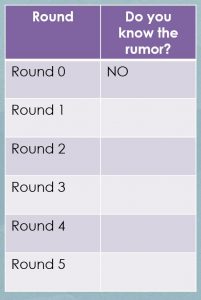
Did you ever play Mad Libs? I loved to play this game on long car rides when I was a kid. You could get books of them in the drug store, and best of all, your parents didn’t mind spending the money to get you a whole package, because it was “educational”!
Now the game has a new online incarnation: http://www.madlibs.com/, and you can even find an app to play it.
In Mad Libs there is a leader, who asks everyone else to give them words to fill in the blanks — but the leader does not tell the rest of the group the story until all the blanks have been filled in! Once the blanks are all filled in, the leader reads the story to much hilarity.
I created my own story, with a twist — it has numbers at the end that students also have to fill in. When my students finish reading out the story, they also read out and do the problems they have created. The particular problems you’ll see below involve factoring, but could be changed to suit any topic. The great thing about this game is that it brings in topics from English (interdisciplinary!) and story telling. It gets students laughing and more ready to do the problems, and it allows students to create their own problems.
Mad Math: Factoring Frenzy
Directions
- The group leader does not show the group this piece of paper!
- The leader asks each person in the group in turn to contribute a word, letter or number until all the blanks are filled in, including the number blanks for the factoring problems.
- If a person gets stuck on a word, they can use one of the ones on the board.
- Then the leader reads the story and the group works out the problems.
My ___________ subway ride started when a giant ___________ _____________ up from the subway adjective animal verb ending in –ed
and into the ____ train. People were ___________, but I got a ___________, so I was ___________.
letter verb ending in –ing noun adjective
When I got to school, my ___________ professor would not ___________my excuse and said that if
adjective verb
was late one more time, I would get a ____. What a ___________ day! Luckily, I found out that if I could
letter adjective
do these ___________ factoring problems, everything would be ___________!
adjective adjective
Factor: Caution: one of the problems is not factorable!
- x2 + 3x – ___ 2. x2 – ___x + 25 3. x2 + 12x + ___
an integer between 3 and 5 an integer between 9 and 11 a perfect square betw 30 &40
4. x2 – ___ 16x2 – ___ 6. x2 + ___
any perfect square an odd perfect square any perfect square
Bonus: change the problem that is not factorable into one that is.
The word file here: mad-math-example gives you a better copy, plus some signs I made up to put around the room so that students would know what an adjective, adverb and noun were.
I invented this game at a What’s Your Game Plan workshop, with the help of Joe Bisz, Carlos Hernandez and Francesco Crocc. Much thanks, you guys!




